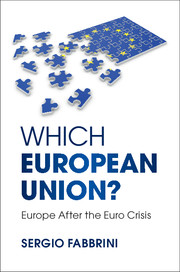Book contents
- Frontmatter
- Dedication
- Contents
- List of boxes
- List of figures
- List of tables
- List of abbreviations
- Preface – How many unions?
- Acknowledgments
- Part I Institutionalization of multiple unions
- 1 From Rome to the Lisbon Treaty
- 2 The Lisbon Treaty and the euro crisis
- 3 Institutionalization and constitutional divisions
- Part II Main perspectives on the European Union
- Part III Towards the compound union perspective
- Appendix
- Glossary
- References
- Index
3 - Institutionalization and constitutional divisions
Published online by Cambridge University Press: 05 March 2015
- Frontmatter
- Dedication
- Contents
- List of boxes
- List of figures
- List of tables
- List of abbreviations
- Preface – How many unions?
- Acknowledgments
- Part I Institutionalization of multiple unions
- 1 From Rome to the Lisbon Treaty
- 2 The Lisbon Treaty and the euro crisis
- 3 Institutionalization and constitutional divisions
- Part II Main perspectives on the European Union
- Part III Towards the compound union perspective
- Appendix
- Glossary
- References
- Index
Summary
Introduction
If it is true that the euro crisis has deepened the divisions within the EU, it is also true that those divisions have constituted a permanent feature of its process of institutionalization. With the progressive deepening of European integration (i.e. the proliferation of public policies decided in Brussels) and its periodical widening, the institutionalization of the EU has grown increasingly more political and less economic (Maduro 2003; Walker 2007), and thus more contentious (Glencross 2014a). The euro crisis has ended up bringing in through the back door the very issue that was not allowed to enter through the front door at the foundation of the EU (after the rejection by the French Assemblée Nationale in 1954 of the EDC project), namely the issue of what the Union should be. In the 1990s, with the end of the Cold War and the prospect of the political reunification of the continent, the dispute on the constitutional identity of the EU came to the fore. The necessity to give a constitutional identity to the EU accompanied the constitutional decade of the 2000s. That necessity was then frozen by the French and Dutch referenda on the CT in 2005. It seemed that the 2009 Lisbon Treaty had finally settled the problem, institutionalizing a truce between the alternative views of the Union. But events have not followed expectations. The euro crisis entered like a tornado against the apparent lethargy that led to the signing of the Treaty, reopening and deepening the old constitutional divisions between member states and bringing to the surface tensions among EU institutions (such as the European Council, on one side, and the EP, on the other). With approval of new intergovernmental treaties, the issue of what the EU is and should be has re-emerged.
As with all established political systems, the EU is also structured around cleavages.
- Type
- Chapter
- Information
- Which European Union?Europe After the Euro Crisis, pp. 64 - 90Publisher: Cambridge University PressPrint publication year: 2015



